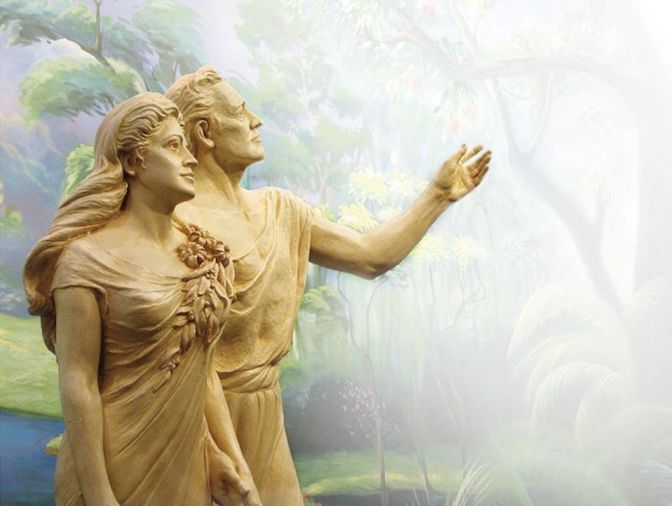Garden of Eden
The home of Adam and Eve is described in scripture as “a garden, eastward in Eden” Genesis 2:8–3:24; and is confirmed in latter-day revelation as the same (Moses 3:8; Abraham 5:8).
“As one of the final steps in the Creation, God planted a garden eastward in Eden and placed in it varieties of animals and plants (Gen. 2:8-9). It was an idyllic environment, without enmity among living things and without death. Adam and Eve were given dominion over all things and directed to cultivate and beautify the garden (Gen. 2:15). However, in this pristine condition.”[1]
- God placed the tree of knowledge of good and evil in the midst of the garden and gave Adam and Eve their agency whether to partake of its fruit (Moses 7:32). Unless they ate, they would remain forever in the garden, limited in their ability to progress and without posterity. However, while partaking would bring opportunity to bear children and to learn good from evil by experience, including sorrow, pain, and death, they would be exiled temporarily from the presence of God. The decision of Eve and Adam to transgress a commandment of God and partake of the fruit of the tree brought mortality and death to them and to their posterity; for it made possible the human family upon the earth (2 Ne. 2:25). The Fall of Adam also made the Atonement of Jesus Christ necessary.[2]
After Adam and Eve partook of the forbidden fruit, they were brought out of the garden of Eden: “Wherefore, I, the Lord God, caused that he should be cast out from the Garden of Eden, from my presence, because of his transgression (Doctrine and Covenants 29:41):
- And after Adam and Eve had partaken of the forbidden fruit they were driven out of the garden of Eden, to till the earth.
- And they have brought forth children; yea, even the family of all the earth.
- And the days of the children of men were prolonged, according to the will of God, that they might repent while in the flesh; wherefore, their state became a state of probation, and their time was lengthened, according to the commandments which the Lord God gave unto the children of men. For he gave commandment that all men must repent; for he showed unto all men that they were lost, because of the transgression of their parents.
- And now, behold, if Adam had not transgressed he would not have fallen, but he would have remained in the garden of Eden.2 Nephi 2:19–22
The Garden of Eden is considered to be mythological by most scholars.[3] However, the Prophet Joseph Smith learned through revelation that the Garden of Eden was located in Jackson County, Missouri.
- Brigham Young stated, “Joseph the Prophet told me that the garden of Eden was in Jackson [County] Missouri.” (Journal of Wilford Woodruff, vol. 5, 15 Mar. 1857, Archives Division, Church Historical Dept., Salt Lake City.) Heber C. Kimball said: “From the Lord, Joseph learned that Adam had dwelt on the land of America, and that the Garden of Eden was located where Jackson County now is.” (Andrew Jenson, Historical Record, 9 vols., Salt Lake City: Andrew Jenson, 1888, 7:439; see also Orson F. Whitney, Life of Heber C. Kimball, Salt Lake City: Bookcraft, 1967, p. 219.) Other early leaders have given the same information.
- Unfortunately, we do not have primary source documentation for all of Joseph Smith’s revelations or doctrinally related declarations. This is especially true for the periods when he did not have a scribe to keep a record of his daily activities. His 1831 and 1832 trips to Missouri fit into this category.[4]
After Adam and Eve were driven out of the Garden of Eden, they resided in a place known as Adam-ondi-Ahman. Revelation given to Joseph Smith in May 1838 (https://www.churchofjesuschrist.org/study/scriptures/dc-testament/dc/116?lang=eng D&C 116]) identifies Adam-ondi-Ahman, a site near the Garden of Eden, to be in Daviess County, Missouri, about seventy miles from present-day Kansas City. Other revelations referring to Adam-ondi-Ahman are D&C 78:15–16 and [https://www.churchofjesuschrist.org/study/ensign/1994/01/i-have-a-question/what-do-we-know-about-the-location-of-the-garden-of-eden?lang=eng
- Three years previous to the death of Adam, he called Seth, Enos, Cainan, Mahalaleel, Jared, Enoch, and Methuselah, who were all ahigh priests, with the residue of his posterity who were righteous, into the valley of bAdam-ondi-Ahman, and there bestowed upon them his last blessing.
- And the Lord appeared unto them, and they rose up and blessed aAdam, and called him Michael, the prince, the archangel.
- And the Lord administered comfort unto Adam, and said unto him: I have set thee to be at the head; a multitude of nations shall come of thee, and thou art a aprince over them forever.
- And Adam stood up in the midst of the congregation; and, notwithstanding he was bowed down with age, being full of the Holy Ghost, apredicted whatsoever should befall his posterity unto the latest generation.D&C 107:53–57
- President Joseph Fielding Smith said: “In accord with the revelations given to the Prophet Joseph Smith, we teach that the Garden of Eden was on the American continent located where the City of Zion, or the New Jerusalem, will be built. When Adam and Eve were driven out of the Garden, they eventually dwelt at a place called Adam-ondi-Ahman, situated in what is now Daviess County, Missouri. … We are committed to the fact that Adam dwelt on [the] American continent.” (Doctrines of Salvation, 3 vols., comp. Bruce R. McConkie, Salt Lake City:Bookcraft, 1956, 3:74. Compare Answers to Gospel Questions, 5 vols., Salt Lake City: Deseret Book Co., 1957–75, 2:93–95, 4:19–24; and Alvin R. Dyer, in Conference Report, Oct. 1968, pp. 108–9.)[5]
Latter-day revelation indicates that Adam will return to Adam-ondi-Ahman during the events prophesied to transpire at the second coming of Jesus Christ. Wrote Joseph Smith, “It is the place where Adam shall come to visit his people, or the Ancient of Days shall sit, as spoken of by Daniel the Prophet" (HC 3:35; D&C 116:1)
